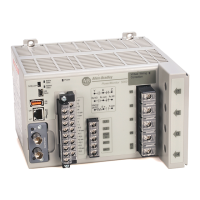Rockwell Automation Publication 1426-UM001J-EN-P - August 2019 501
Glossary
FFT Fast Fourier Transform A mathematical technique for decomposing an AC waveform consisting of a
fundamental frequency and one or more harmonics into separate components
that represent the magnitude and phase angle of the fundamental and each of the
harmonics present. The bandwidth of the input signal must be limited according
to the capability of the measuring device.
Flicker Low frequency variation in lighting intensity, caused by voltage fluctuations, that
can cause discomfort or neurological effects in sensitive individuals. See also
Volta g e Fluctuati on.
Frequency The number of recurrences of a periodic phenomenon in a unit of time. In
electrical terms, frequency is specified as so many Hertz (Hz) where one Hz
equals one cycle per second.
Fundamental Frequency With regard to an electrical power system, fundamental frequency is the nominal
frequency of the system, that is, 50 Hz or 60 Hz.
Harmonic Group The rms value that is obtained for a given harmonic by combining the harmonic
rms magnitude with a defined number of adjacent interharmonic rms values. See
EN 61000-4-7
for more details.
Harmonics AC frequency components that are integer multiples of the fundamental
frequency. For example, 180 Hz is the third harmonic in a 60 Hz system.
Horsepower (hp) A unit of power, or the capacity of a mechanism to do work. Horsepower is
equivalent to raising 33,000 pounds one foot in one minute. One horsepower
equals 746 watts.
IEC 61000-4-30 See EN 61000-4-30.
IEC 61000-4-7 See EN 61000-4-7.
IEC 61000-4-15 See EN 61000-4-15.
IEEE 1159 The IEEE recommended practice for monitoring electric power quality.
IEEE 519 The IEEE recommended practices and requirements for harmonic control in
electrical power systems.
Imbalance In a three-phase system, imbalance is a measure of the extent to which the
magnitudes of the three phase voltages (or currents) are not equal in magnitude
and/or the phase angle between the phases is not 120°. Computed as the ratio of
the negative sequence component to the positive sequence component.
Imbalance results in unwanted losses in the power system and can result in
excessive heating of rotating equipment.
Impedance The total opposition (that is, resistance and reactance) a circuit offers to the flow
of alternating current at a given frequency. Impedance is measured in ohms.

